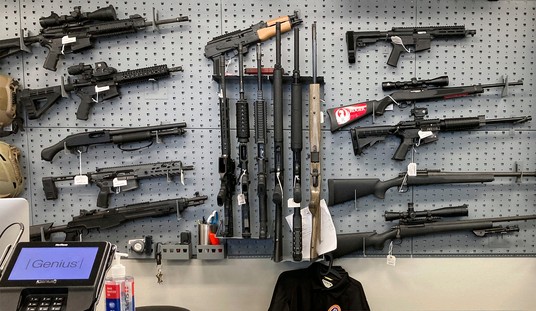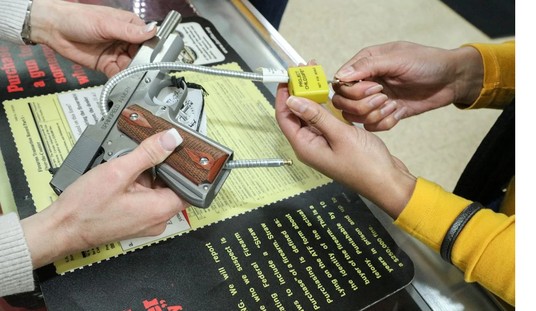With the exception of when moving may actually threaten our survival; the number one rule in a defensive situation is to move away from your attacker. Creating distance between you and the bad guy or "Getting off the X" as they say, is the name of the game. Whether you strike and move or just move, the point is you are moving. For many people that simply is not an option. They must deal with their attacker to the best of their ability right where they are. While this may not be ideal, it can still be accomplished quite effectively.
Who would not be moving to create distance with their attacker? The handicapped. People with disabilities represent approximately 20 percent of the population of our country, but are victims at a much higher rate than the general public. Research shows these numbers to be four to five times higher, and that is on the conservative end. For many handicapped CCW holders the "regular" training methods of moving and shooting are just not applicable to their personal situation. This is where my story begins. I am a firearms instructor for Precision Defensive Shooting School in Colorado. I was contacted by a lady, Angie, who wanted to take a defensive handgun class to obtain her concealed carry permit. In talking with her she was quick to point out that she uses a wheelchair. While I have taught many defensive pistol classes, I must admit that until this woman contacted me, I had not had anyone in a wheelchair take a class.
After explaining to Angie my lack of experience in this area, I agreed to teach her. I told her that before we set a date for her class, I wanted to do my homework on this area of firearms training so she would be getting the most out of the class. I already knew that just modifying the regular training curriculum to accommodate someone sitting in a wheelchair would not be the best direction to go, but in order to offer training that they can benefit from I needed a better understanding of what a handicapped person must deal with. That’s when the research started.
Once you sift through the big egos, mall commandos, and unfounded opinions, internet gun forums can be valuable resources. Quite simply, they can put you in contact with people who have experience in what you are trying to find. After corresponding with various other firearms instructors from around the country, going through various scenarios in my mind, and actually experimenting with putting myself in a wheelchair, I felt I was ready to teach the class.
In trying to define an overall direction or message that I wanted to project throughout the class, I got in touch with Tom Givens. Tom is the owner and chief instructor at Rangemaster in Tennessee. He is nationally known for his years of experience with firearms training, including working with handicapped shooters. His advice was, "focus on what they can do and not what they cannot." That was exactly my focus throughout the class. It definitely reinforced the positive to the student while still being realistic. Tom offered up many ideas and various areas of training to focus on that proved to be of great value during the class.
Once we covered the basic CCW information, safety, and various other topics, we started out by exploring which method of carry would work best for Angie. Although crossdraw and shoulder holsters are quite popular for those who do a lot of sitting or riding, she chose to go with a fanny pack as her method of carry. If she were knocked from her chair it would be easy to get separated from her purse, but a fanny pack would remain attached to her person, allowing her the full use of her hands and arms without having to scramble for her purse. A purse would require her to hold onto it, which might prevent the use of a hand desperately needed for other tasks. My student also pointed out that many times she holds her small child in her lap while her purse is hanging on the handles of the wheelchair. She simply doesn’t have enough room for both a full size purse and a child in her lap at one time. The function and concealability in using the fanny pack worked quite well for her situation. However, she agreed she would probably experiment with a crossdraw style holster somewhere down the line.
We worked with basic draw techniques, and firing from retention, which Angie was able to do without any major difficulties. Once she had become comfortable with basic shooting, we discussed one-handed techniques to include both strong hand and weak hand. She quickly saw the value in this, because her weak hand is usually manipulating and stabilizing her wheelchair. We discussed the issues with both a revolver and a semi-auto and let her get the experience of firing both. Once again, I went back to what Tom Givens had said concerning his experience with one particular handicapped student. In short, "A higher capacity gun lessens the probability of having to reload, but it can be loaded and manipulated with one hand if need be." True words indeed. She also liked the idea of more shots available to her. Anyone who has tried to load a revolver one handed would have to agree that in this case, a semi-auto would be the easier way to go. A semi-auto it was. She spent the rest of the class with a Springfield Armory XD subcompact in 9mm.
In staying with the "focus on what you can do" mentality while still maintaining what is realistic, I explained that the likelihood of ending up on the ground is very real. People who are bent on targeting someone in a wheelchair think that knocking them out of their chair and onto the ground will render them helpless. Not so! My student quickly found that she can defend herself very effectively from the ground. We simulated several scenarios of her getting thrown from her chair or pushed to the ground. Of course we didn’t actually throw her to the ground! We had her shooting from several positions. She even stated that she felt more comfortable on the ground because she had more movement available to her.
A very real concern of Angie’s was how vulnerable she felt during the times of getting in and out of her vehicle. We teach the value of awareness quite heavily during our classes, and offered several suggestions and techniques that might work for her. For example, don’t let yourself become so focused on the task at hand that you become unaware of your surroundings. This can easily happen while burdened with the task of loading and unloading your chair into your vehicle. Fortunately, this student has children who are old enough to help. Teaching them to be aware of their surroundings during these times can give her a second set of eyes to be on watch. Learning to use whatever you have available is crucial, and will give you an edge over any wrongdoers. As she pointed out, her husband travels with her most of the time. So, we worked with the two of them together on operating as a team. The advantages of teamwork became obvious to them as they worked on "covering" each other. By working together, they were able to have one getting into the vehicle while the other kept a watchful eye . In doing this, they quickly gained confidence in their abilities.
This training class quickly turned into a learning experience for me as well as for the student. You must be able to listen to the concerns of each individual in order to come up with solutions that will work for their particular situation. One thing that became quite clear early on was the need for one-handed shooting. While we normally cover the possibility of shooting one-handed (both strong and weak), that possibility quickly becomes a probability for someone in a wheelchair. The normal two-handed technique was achieved quite easily in the wheelchair with very minimal adaptations. The limited range of movement was an obstacle, but that was easily overcome by shooting one handed. She was quick to discover that although she did not have the ability to move her chair and fire two-handed 360 degrees around her, she could do it one-handed quite effectively. We had her chair positioned with targets on the sides and behind her. Simply staying upright in the chair and twisting behind her worked as well as the technique of slightly leaning forward and looking back (the gun is almost sideways at this point.) If the upper body is limited in its ability to twist, the leaning forward technique would probably work best. Both worked very well in achieving hits ranging from the sides to directly behind her.
Throughout the day, we had this student shooting at various stationary targets, moving targets, multiple targets, and even an up close and "attacking" a target built just for this class. As her ability and comfort level improved during the course of the day, her confidence grew by leaps and bounds. She discovered that being in a wheelchair doesn’t have to mean that she is limited in her ability to defend herself. There are techniques to overcome most of the limits that living in a wheelchair can put on someone. They just need to learn and practice them. She did have to face the reality of not being able to shoot and get away from her attacker. This was overcome by stressing the need to "shoot until the threat stops." That is something that one can do. Being able to shoot from the retention position is critical in this type of situation, as the attacker will very likely be in one’s personal space in a matter of seconds. This was stressed, practiced, and performed very well during the class. She took a very realistic view of what the possibilities could be in that type of situation. In my opinion, it is crucial to focus on the positive while still maintaining an honest and realistic view during any type of training.
In conclusion, I felt we were able to accomplish what we set out to do. For her, as I’m sure it is with most disabled people, it isn’t just about being able to shoot a handgun. It is about being able to overcome a set of obstacles to find out that you can effectively defend yourself no matter what the circumstances may be. There is no doubt that this can definitely be done. As for the student, the chair did not stop her. She has options, and she is gaining the skills to use them in the world that we live in. Whatever it takes, get the training and strive to not become a victim.
Thanks to our friends at the United States Concealed Carry Association. To learn more about concealed carry click here.








Join the conversation as a VIP Member